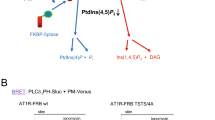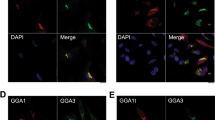Abstract
Phosphoinositide 3-kinase (PI(3)K) is a unique enzyme characterized by both lipid and protein kinase activities. Here, we demonstrate a requirement for the protein kinase activity of PI(3)K in agonist-dependent β-adrenergic receptor (βAR) internalization. Using PI(3)K mutants with either protein or lipid phosphorylation activity, we identify the cytoskeletal protein non-muscle tropomyosin as a substrate of PI(3)K, which is phosphorylated in a wortmannin-sensitive manner on residue Ser 61. A constitutively dephosphorylated (S61A) tropomyosin mutant blocks agonist-dependent βAR internalization, whereas a tropomyosin mutant that mimics constitutive phosphorylation (S61D) compliments the PI(3)K mutant, with only lipid phosphorylation activity reversing the defective βAR internalization. Notably, knocking down endogenous tropomyosin expression using siRNAs that target different regions of tropomyosin resulted in complete inhibition of βAR endocytosis, showing that non-muscle tropomyosin is essential for agonist-mediated receptor internalization. These studies demonstrate a previously unknown role for the protein phosphorylation activity of PI(3)K in βAR internalization and identify non-muscle tropomyosin as a cellular substrate for protein kinase activity of PI(3)K.
This is a preview of subscription content, access via your institution
Access options
Subscribe to this journal
Receive 12 print issues and online access
$209.00 per year
only $17.42 per issue
Buy this article
- Purchase on Springer Link
- Instant access to full article PDF
Prices may be subject to local taxes which are calculated during checkout








Similar content being viewed by others
References
Rockman, H. A., Koch, W. J. & Lefkowitz, R. J. Seven-transmembrane-spanning receptors and heart function. Nature 415, 206–212 (2002).
Koch, W. J., Lefkowitz, R. J. & Rockman, H. A. Functional consequences of altering myocardial adrenergic receptor signaling. Annu. Rev. Physiol. 62, 237–260 (2000).
Lefkowitz, R. J. G protein-coupled receptors. III. New roles for receptor kinases and β-arrestins in receptor signaling and desensitization. J. Biol. Chem. 273, 18677–18680 (1998).
Naga Prasad, S. V. et al. Phosphoinositide 3-kinase regulates β2-adrenergic receptor endocytosis by AP-2 recruitment to the receptor/β-arrestin complex. J. Cell Biol. 158, 563–575 (2002).
Rameh, L. E. & Cantley, L. C. The role of phosphoinositide 3-kinase lipid products in cell function. J. Biol. Chem. 274, 8347–8350 (1999).
Vanhaesebroeck, B. et al. Synthesis and function of 3-phosphorylated inositol lipids. Annu. Rev. Biochem. 70, 535–602 (2001).
Stoyanov, B. et al. Cloning and characterization of a G protein-activated human phosphoinositide-3 kinase. Science 269, 690–693 (1995).
Carpenter, C. L. et al. A tightly associated serine/threonine protein kinase regulates phosphoinositide 3-kinase activity. Mol. Cell. Biol. 13, 1657–1665 (1993).
Dhand, R. et al. PI 3-kinase is a dual specificity enzyme: autoregulation by an intrinsic protein-serine kinase activity. EMBO J. 13, 522–533 (1994).
Walker, E. H., Perisic, O., Ried, C., Stephens, L. & Williams, R. L. Structural insights into phosphoinositide 3-kinase catalysis and signalling. Nature 402, 313–320 (1999).
Pirola, L. et al. Activation loop sequences confer substrate specificity to phosphoinositide 3-kinase α (PI3Kα). Functions of lipid kinase-deficient PI3Kα in signaling. J. Biol. Chem. 276, 21544–21554 (2001).
Naga Prasad, S. V., Barak, L. S., Rapacciuolo, A., Caron, M. G. & Rockman, H. A. Agonist-dependent recruitment of phosphoinositide 3-kinase to the membrane by β-adrenergic receptor kinase 1. A role in receptor sequestration. J. Biol. Chem. 276, 18953–18959 (2001).
Perrino, C. et al. Restoration of β-adrenergic receptor signaling and contractile function in heart failure by disruption of the βARK1/phosphoinositide 3-kinase complex. Circulation 111, 2579–2587 (2005).
Ma, A. D., Metjian, A., Bagrodia, S., Taylor, S. & Abrams, C. S. Cytoskeletal reorganization by G protein-coupled receptors is dependent on phosphoinositide 3-kinase γ, a Rac guanosine exchange factor, and Rac. Mol. Cell. Biol. 18, 4744–4751 (1998).
Nienaber, J. J. et al. Inhibition of receptor-localized PI3K preserves cardiac β-adrenergic receptor function and ameliorates pressure overload heart failure. J. Clin. Invest. 112, 1067–1079 (2003).
Fujimoto, L. M., Roth, R., Heuser, J. E. & Schmid, S. L. Actin assembly plays a variable, but not obligatory role in receptor-mediated endocytosis in mammalian cells. Traffic 1, 161–171 (2000).
Lamaze, C., Chuang, T. H., Terlecky, L. J., Bokoch, G. M. & Schmid, S. L. Regulation of receptor-mediated endocytosis by Rho and Rac. Nature 382, 177–179 (1996).
Czupalla, C. et al. Identification and characterization of the autophosphorylation sites of phosphoinositide 3-kinase isoforms β and γ. J. Biol. Chem. 278, 11536–11545 (2003).
Vanhaesebroeck, B. et al. Autophosphorylation of p110δ phosphoinositide 3-kinase: a new paradigm for the regulation of lipid kinases in vitro and in vivo. EMBO J. 18, 1292–1302 (1999).
Bondeva, T. et al. Bifurcation of lipid and protein kinase signals of PI3Kγ to the protein kinases PKB and MAPK. Science 282, 293–296 (1998).
Perry, S. V. Vertebrate tropomyosin: distribution, properties and function. J. Muscle Res. Cell. Motil. 22, 5–49 (2001).
Pittenger, M. F., Kazzaz, J. A. & Helfman, D. M. Functional properties of non-muscle tropomyosin isoforms. Curr. Opin. Cell Biol. 6, 96–104 (1994).
Sano, K., Maeda, K., Oda, T. & Maeda, Y. The effect of single residue substitutions of serine-283 on the strength of head-to-tail interaction and actin binding properties of rabbit skeletal muscle α-tropomyosin. J. Biochem. (Tokyo) 127, 1095–1102 (2000).
Houle, F. et al. Extracellular signal-regulated kinase mediates phosphorylation of tropomyosin-1 to promote cytoskeleton remodeling in response to oxidative stress: impact on membrane blebbing. Mol. Biol. Cell 14, 1418–1432 (2003).
Merrifield, C. J., Feldman, M. E., Wan, L. & Almers, W. Imaging actin and dynamin recruitment during invagination of single clathrin-coated pits. Nature Cell Biol. 4, 691–698 (2002).
Merrifield, C. J. et al. Endocytic vesicles move at the tips of actin tails in cultured mast cells. Nature Cell Biol. 1, 72–74 (1999).
Gottlieb, T. A., Ivanov, I. E., Adesnik, M. & Sabatini, D. D. Actin microfilaments play a critical role in endocytosis at the apical but not the basolateral surface of polarized epithelial cells. J. Cell Biol. 120, 695–710 (1993).
Qualmann, B., Kessels, M. M. & Kelly, R. B. Molecular links between endocytosis and the actin cytoskeleton. J. Cell Biol. 150, F111–F116 (2000).
Cooper, J. A. Actin dynamics: tropomyosin provides stability. Curr. Biol. 12, R523–525 (2002).
Rapacciuolo, A. et al. Protein kinase A and G protein-coupled receptor kinase phosphorylation mediates β-1 adrenergic receptor endocytosis through different pathways. J. Biol. Chem. 278, 35403–35411 (2003).
Brodsky, F. M., Chen, C. Y., Knuehl, C., Towler, M. C. & Wakeham, D. E. Biological basket weaving: formation and function of clathrin-coated vesicles. Annu. Rev. Cell Dev. Biol. 17, 517–568 (2001).
Gaidarov, I. & Keen, J. H. Phosphoinositide-AP-2 interactions required for targeting to plasma membrane clathrin-coated pits. J. Cell Biol. 146, 755–764 (1999).
Kohout, T. A., Lin, F. S., Perry, S. J., Conner, D. A. & Lefkowitz, R. J. β-Arrestin 1 and 2 differentially regulate heptahelical receptor signaling and trafficking. Proc. Natl Acad. Sci. USA 98, 1601–1606 (2001).
Johnson, D. A., Akamine, P., Radzio-Andzelm, E., Madhusudan, M. & Taylor, S. S. Dynamics of cAMP-dependent protein kinase. Chem. Rev. 101, 2243–2270 (2001).
Horne, J., Jennings, I. G., Teh, T., Gooley, P. R. & Kobe, B. Structural characterization of the N-terminal autoregulatory sequence of phenylalanine hydroxylase. Protein Sci. 11, 2041–2047 (2002).
Naga Prasad, S. V., Esposito, G., Mao, L., Koch, W. J. & Rockman, H. A. Gβγ-dependent phosphoinositide 3-kinase activation in hearts with in vivo pressure overload hypertrophy. J. Biol. Chem. 275, 4693–4698 (2000).
Acknowledgements
This work was supported in part by National Institutes of Health grants PO1 HL 075443 (to H.A.R) and Beginning grant-in-aid from AHA, Mid-Atlantic affiliate (to S.V.N.P.). A.J. received a Howard Hughes Medical Student Research Award. We thank W. Zou for her excellent technical assistance. We also thank M. Delahunty and X. Q. Zhang for excellent technical assistance with the SF9 cells. We would like to thank J. Richardson and D. Richardson (Department of Biochemistry, Duke University Medical Center) for advice and thoughtful insights on the crystallographic structure of PI(3)Kγ and the PI(3)K mutants.
Author information
Authors and Affiliations
Corresponding author
Ethics declarations
Competing interests
The authors declare no competing financial interests.
Supplementary information
Supplementary Information
Supplementary figures S1, S2 and supplementary methods (PDF 367 kb)
Rights and permissions
About this article
Cite this article
Naga Prasad, S., Jayatilleke, A., Madamanchi, A. et al. Protein kinase activity of phosphoinositide 3-kinase regulates β-adrenergic receptor endocytosis. Nat Cell Biol 7, 785–796 (2005). https://doi.org/10.1038/ncb1278
Received:
Accepted:
Published:
Issue Date:
DOI: https://doi.org/10.1038/ncb1278
This article is cited by
-
First profiling of lysine crotonylation of myofilament proteins and ribosomal proteins in zebrafish embryos
Scientific Reports (2018)
-
Functionally distinct and selectively phosphorylated GPCR subpopulations co-exist in a single cell
Nature Communications (2018)
-
Phosphorylation of tropomyosin in striated muscle
Journal of Muscle Research and Cell Motility (2013)
-
Nerve growth factor-induced endocytosis of TWIK-related acid-sensitive K+ 1 channels in adrenal medullary cells and PC12 cells
Pflügers Archiv - European Journal of Physiology (2013)
-
Regulation of endothelial permeability and transendothelial migration of cancer cells by tropomyosin-1 phosphorylation
Vascular Cell (2012)



